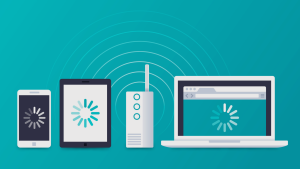Archive for April, 2022
Earth Day and Your Data Center – Green is Not What It Used To Be no comments

As we celebrate Earth Day, many businesses, organizations and individuals will take additional time to reflect on their impact on our environment and the contributions we can all make to a sustainable future. Organizations like EarthDay.org help spearhead awareness and direct-action options we can all consider in our own lives to be ‘greener’.
The term “Green”, “Being Green” or “Going Green” all have multiple variations and meanings, but in general, we all accept that it means to help sustain the environment in some fashion. Many years ago, the Earth Day movement started more with a focus about recycling. Today, it has evolved into an awareness of sustainability by reducing overall carbon footprints through less consumption (and output of non-renewable resources to produce the goods and/or power we consume).
One of the largest non-green impacting areas we see is electronic devices like our mobile devices, computers, and servers. While desktop computers at least have power saving modes that often can reduce their usage, they still consume (and impact the environment) roughly the same as 4,500 miles driven per year of a typical US car. Servers are the worst offenders of the bunch, running 24/7, consuming large amounts of energy to keep your email, files, apps, and websites running all the time even when we are asleep.
Those high energy consuming servers, and in some cases office desktop PC’s, can all be moved to the cloud through cloud-based servers and colocation. It may not seem obvious, but moving your servers and desktop PCs into the cloud can make a huge impact. While data centers can consume massive amounts of energy to keep those cloud-based servers running 24 hours a day (especially the massive industrial air conditioning and redundant power systems in place to support these facilities), the fact is that data centers can be scaled up to effectively utilize the best-in-class options to be efficient and sourced from green energy, to substantially reduce, or in fact eliminate their entire carbon footprint. If you colocate or host your servers in such a data center, you effectively reduce your impact on our environment significantly.
TurnKey Internet’s Green Data Center was built to have an effective carbon footprint of zero – sourcing all its power from a massive on-site solar array and hydro-electric power provided by New York State’s Recharge NY program, on top of the most cutting-edge power efficiency and data center cooling technology. TurnKey Internet’s state-of-the-art data center won the New York State Environmental Excellence award and The U.S. Federal Government’s Environmental Protection Agency awarded the facility the 2nd only New York Energy Star Certified Data Center designation.
So from our stand point, green is about minimizing or having zero impact on the environment – and more so, we are helping businesses take their office servers, computers, and other IT infrastructure into the cloud to minimize their carbon footprints too. This Earth Day, take a look around your home or office – and see what small changes you can do to help improve your impact on the world.
Follow Us :Share :
Why Website Speed Matters no comments

If you’re in a store and ready to check out but you can’t find someone to help you, chances are you’ll stick around. You may even wait quite a while since you’ve gone through all the trouble of going to a store and selecting which items you want. However, if you’re waiting a long time for a website to respond, you can be on another site making the same selections within seconds.
For this reason, it’s essential that your website runs quickly and loads within mere seconds. People have a large selection of websites that they can get information from or do business with, and you need to be sure that your site is providing what people want very quickly. Additionally, it’s not just sites that sell items that need speedy load times. Sites that generate revenue from ads also need to load quickly to prevent the loss of income.
Importance of Website Performance and Speed
It is important to understand that today’s customer is always online. This means that if they want to access information online, they will do it through multiple devices. Speed is an integral part of the user experience. This blog details the top reasons why website speed is important and why it is essential to optimize website speed.
It Can Lower Your Conversion Rate
Studies show that people are steadily becoming less patient when it comes to waiting for web pages to load; 47 percent of people expect a website to load in two seconds or less. For mobile sites, you are given about three seconds before more than half of the visitors say they will leave. Even if you’re getting people to stick around, a slow load time can drop your conversion rate.
A study done by Amazon showed that just a 0.1 second slower load time resulted in a one percent decrease in sales. While Amazon is enormous and your website may not be able to generate that much traffic or sales, it shows that even tiny slowdowns can still have a tangible effect on your business. If slow load speeds are driving people away, then it’s driving your sales away.
Search Engine Ranking
If you run a business website, you’re probably at least familiar with the concept of search engine optimization, which involves signaling to search engines that people who are searching for particular terms or phrases would benefit from visiting your site. Google, and other search engines, include user experience as a metric when determining where your website will end up in search engine results.
User experience includes several things, including the quality of content on a site, if it’s easy to navigate and how quickly the website loads. Google doesn’t generally release specific information about how metrics are weighted, but a slow website can dramatically reduce your user experience score. With SEO being so competitive, the last thing you want is a slow website dragging your ranking down.
User Experience
One of the reasons that user experience is a part of many search engine ranking metrics is because people tend to not return to websites that worked poorly for them. Research done by Statista indicates that almost 80% of shoppers will abandon an online shopping cart if the website is too difficult to use.
Having a slow website can also make visitors do more than just wait. It can also keep certain parts of your site from working because scripts still need to load. Someone may fill out a form or attempt to add an item to a shopping cart and get an error or find that nothing is happening.
Additionally, when a website is slow, it may not load properly or things on the page may start adjusting themselves, changing the locations of images and text as people are trying to read or use the site. These types of frustrations can easily send someone away from your site with a commitment to never return.
The Need for Speed on Mobile
Mobile users can be even more impatient than people on desktops. With the number of individuals using mobile devices to both surf the web and make purchases, you mustn’t be driving away customers and visitors with a slow site. In addition to needing to create mobile and desktop versions of your site, you need to be sure that mobile versions load quickly and aren’t just designed to fit on a smaller screen.
People on mobile devices often have data caps, and although powerful, smartphones have far less processing power than computers. Images need to be shrunk in terms of both pixels and file sizes, and scripts need to be kept down to the minimum required for the site to function. Along with rating user experience for desktop websites, Google also measures user experience for mobile sites. Furthermore, in the last year, they’ve started ranking mobile-friendly sites higher when people do searches on a mobile device.
Loss of Ad Revenue
Depending on the ad network that your website is hosting advertising from, you may only get credit for ad views if the ad loads properly if the visitor to the page has the ad show up on their screen, or both. If your website is very slow, ads may not be loading properly, depriving you of revenue. Google found that 25 percent of mobile sites with load times under five seconds had higher ad revenue.
Resolving Your Speed Problems
Whether you have a slow site or would just like your site to run faster than it already is, one of the first things you should look at is cutting down on scripts and reducing the size of image and media files. Scripts can slow down even a bare-bones site because they use a server’s bandwidth, processing power from the server, and processing power from the computer they are being loaded on. Unless your site – and the page that someone is on – needs a script or function to run, consider ditching it.
Media files can also dramatically increase the amount of time that it takes for a site to load. Instead of eliminating image files, see if you can’t compress them or use another file type that results in a smaller image. A small loss in image quality can cut an image’s file size in half.
Another consideration is the server or hosting provider you’re using. You may need more bandwidth or processing power, and if you’re using shared hosting, it may be time to upgrade to a VPS or Dedicated Server solution.
Speed matters. It affects your user experience; it affects your search ranking. It affects your sales and conversions.
Follow Us :Share :



